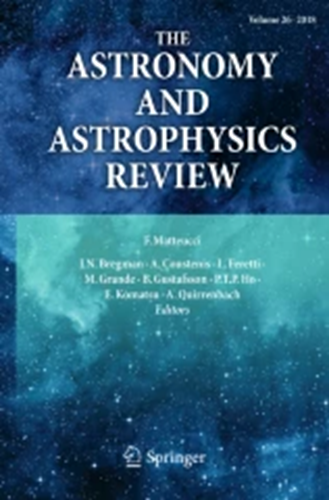Infrared spectra of complex organic molecules in astronomically relevant ice mixtures: IV. Methylamine
IF 26.5
1区 物理与天体物理
Q1 ASTRONOMY & ASTROPHYSICS
引用次数: 9
Abstract
Context. In the near future, high spatial and spectral infrared (IR) data of star-forming regions obtained by the James Webb Space Telescope may reveal new solid-state features of various species, including more intriguing classes of chemical compounds. The identification of complex organic molecules (COMs) in the upcoming data will only be possible when laboratory IR ice spectra of these species under astronomically relevant conditions are available for comparison. For this purpose, systematic series of laboratory measurements are performed, providing high-resolution IR spectra of COMs. Here, spectra of pure methylamine (CH3NH2) and methylamine-containing ices are discussed. Aims. The work is aimed at characterizing the mid-IR (500–4000 cm−1, 20–2.5 μm) spectra of methylamine in pure and mixed ices to provide accurate spectroscopic data of vibrational bands that are most suited to trace this species in interstellar ices. Methods. Fourier transform infrared spectroscopy is used to record spectra of CH3NH2 in the pure form and mixed with H2O, CH4, and NH3, for temperatures ranging from 15 to 160 K. The IR spectra in combination with HeNe laser (632.8 nm) interference data of pure CH3NH2 ice was used to derive the IR band strengths of methylamine in pure and mixed ices. Results. The refractive index of amorphous methylamine ice at 15 K was determined as being 1.30± 0.01. Accurate spectroscopic information and band strength values are systematically presented for a large set of methylamine-containing ices and different temperatures. Selected bands are characterized and their use as methylamine tracers is discussed. The selected bands include the following: the CH3 antisymmetric stretch band at 2881.3 cm−1 (3.471 μm), the CH3 symmetric stretch band at 2791.9 cm−1 (3.582 μm), the CH3 antisymmetric deformation bands, at 1455.0 and 1478.6 cm−1 (6.873 and 6.761 μm), the CH3 symmetric deformation band at 1420.3 cm−1 (7.042 μm), and the CH3 rock at 1159.2 cm−1 (8.621 μm). Using the laboratory data recorded in this work and ground-based spectra of ices toward YSOs (Young Stellar Objects), upper-limits for the methylamine ice abundances are derived. In some of these YSOs, the methylamine abundance is less than 4% relative to H2O.与天文学相关的冰混合物中复杂有机分子的红外光谱:IV.甲胺
上下文。在不久的将来,詹姆斯韦伯太空望远镜获得的恒星形成区域的高空间和光谱红外(IR)数据可能会揭示各种物质的新固态特征,包括更有趣的化合物类别。只有当这些物种在天文相关条件下的实验室红外冰光谱可供比较时,才能在即将到来的数据中识别复杂有机分子(COMs)。为此,进行了系统的一系列实验室测量,提供了COMs的高分辨率红外光谱。本文讨论了纯甲胺(CH3NH2)和含甲胺冰的光谱。目标这项工作的目的是表征纯冰和混合冰中甲胺的中红外光谱(500-4000 cm−1,20 - 2.5 μm),以提供最适合在星际冰中追踪该物种的振动带的精确光谱数据。方法。傅里叶变换红外光谱用于记录纯CH3NH2与H2O, CH4和NH3混合,温度范围为15至160 K的光谱。利用红外光谱结合纯CH3NH2冰的HeNe激光(632.8 nm)干涉数据,推导了纯冰和混合冰中甲胺的红外波段强度。结果。测定了15 K时非晶态甲胺冰的折射率为1.30±0.01。系统地给出了大量含甲胺冰和不同温度下的精确光谱信息和波段强度值。选定的波段进行了表征,并讨论了它们作为甲胺示踪剂的用途。选取的条带包括:CH3反对称拉伸条带2881.3 cm−1 (3.471 μm)、CH3对称拉伸条带2791.9 cm−1 (3.582 μm)、CH3反对称变形条带1455.0和1478.6 cm−1(6.873和6.761 μm)、CH3对称变形条带1420.3 cm−1 (7.042 μm)和CH3岩石1159.2 cm−1 (8.621 μm)。利用本工作中记录的实验室数据和朝向YSOs(年轻恒星天体)的冰的地面光谱,导出了甲胺冰丰度的上限。在其中一些yso中,相对于H2O,甲胺丰度低于4%。
本文章由计算机程序翻译,如有差异,请以英文原文为准。
求助全文
约1分钟内获得全文
求助全文
来源期刊

The Astronomy and Astrophysics Review
地学天文-天文与天体物理
CiteScore
45.00
自引率
0.80%
发文量
7
期刊介绍:
The Astronomy and Astrophysics Review is a journal that covers all areas of astronomy and astrophysics. It includes subjects related to other fields such as laboratory or particle physics, cosmic ray physics, studies in the solar system, astrobiology, instrumentation, and computational and statistical methods with specific astronomical applications. The frequency of review articles depends on the level of activity in different areas. The journal focuses on publishing review articles that are scientifically rigorous and easily comprehensible. These articles serve as a valuable resource for scientists, students, researchers, and lecturers who want to explore new or unfamiliar fields. The journal is abstracted and indexed in various databases including the Astrophysics Data System (ADS), BFI List, CNKI, CNPIEC, Current Contents/Physical, Chemical and Earth Sciences, Dimensions, EBSCO Academic Search, EI Compendex, Japanese Science and Technology, and more.
 求助内容:
求助内容: 应助结果提醒方式:
应助结果提醒方式:


